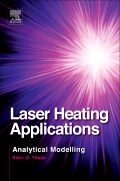Laser Heating Applications

Laser Heating Applications provides deep insight into those areas of thermodynamics which prove conductive to equilibrium and non-equilibrium laser heating theories, in addition to yielding results that serve as data for further theories.
As would be expected, the first theoretical investigations into the heating action of a laser beam were not solutions of Fourier's heat equation. The boundary conditions used varied in their conformity to the problem, but the ease with which they gave plausible results recommended their use. As laser technology has advanced, the search for a better understanding of the heating effects made it apparent that, even with elaborate restraints of Fourier's equation, solutions were still inadequate. This may be overcome using the hyperbolic heat conduction approach, but this theory only covers for the one dimensional heating process.
In order to expose how laser works in practice, the applications of laser processing are introduced briefly in the first chapter. Since predictions of the surface temperature of metals were based on Fourier heat conduction, the Fourier equation is covered first. The mechanism of heat transfer encompasses the analysis of theoretical results with experimental findings. A review of relevant publications is included within the main text. Mathematical derivations have been developed in the relevant sections. Analytical models of cutting are covered, with their failures and successes discussed, and solutions for remediation presented. Non-equilibrium heating approaches are also discussed in the conduction process.
Key Features
Key features of Laser Heating Applications include:
- Detailed analytical solutions for laser heating problems (including thermal stress) aids analysis of linkage between process parameters, such as laser pulse and laser intensity, and material response, such as temperature and stress
- Encompasses practical solutions to thermal heating problems (unlike the length solutions of numerical schemes)
- Extensive fourier and non-fourier treatments and consequent analysis provides improved understanding of mathematical transformations
https://shop.elsevier.com/books/laser-heating-applications/yilbas/978-0-12-415782-8
Terms
While we only use edited and approved content for Azthena
answers, it may on occasions provide incorrect responses.
Please confirm any data provided with the related suppliers or
authors. We do not provide medical advice, if you search for
medical information you must always consult a medical
professional before acting on any information provided.
Your questions, but not your email details will be shared with
OpenAI and retained for 30 days in accordance with their
privacy principles.
Please do not ask questions that use sensitive or confidential
information.
Read the full Terms & Conditions.